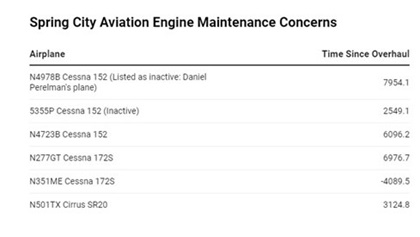What data are you putting out there?
The data you put out publicly as a flight training provider may be used against you if things go badly.
In 2022 a Milwaukee news station website called out a flight training provider’s data that was publicly available.
Specifically, the article questioned, “Less than a week after Daniel Perelman, an 18-year-old student pilot, died after crashing an airplane, the I-Team discovered information on Spring City Aviation’s (SCA) website suggesting that the plane he was flying may have been overdue for critical maintenance.”
The article included a chart that seems to show that many of the flight school’s aircraft were critically beyond the manufacturer’s recommended time since overhaul of engines.
 The article stated, “You have four airplanes well over the manufacturer’s recommendation,” the I-Team’s Shaun Gallagher asked. “Are they flying?”
The article stated, “You have four airplanes well over the manufacturer’s recommendation,” the I-Team’s Shaun Gallagher asked. “Are they flying?”
It’s a fair question for the media to ask, especially when a flight training provider is putting information out publicly that seems to indicate they may be operating in a way that does not comply with the manufacturer's recommendations for safe operations.
I’m not writing this to pick on Spring City Aviation. Honestly, I haven’t dug any deeper into the accident that caused this news station to generate the article they did. What I am writing about here is that a flight training provider should carefully consider, craft, and understand what information is being put out publicly about its operation.
In this article, the numbers that are being quoted don’t seem to be logical to a savvy aviator’s eye. It would be pretty amazing for an engine to make it 6,000 or 7,000 hours without an overhaul being completed. It would even be stranger to have an engine be in negative hours. Aviators who are knowledgeable of engine logbooks and maintenance practices would question these things, but not the general public. Or worse, a jury.
I suspect the reported numbers in the chart in this article were completely wrong, weren’t being updated in a system that was reporting them, and wildly diverged from what you might find in the actual aircraft logbooks. Hopefully, that was the case whenever anyone looked at them as a part of an accident investigation or if a lawsuit arose later. In this case, the actual logbooks of the aircraft would tell an interested party if the aircraft were being maintained properly.
But from a public perspective, that is too far down the investigation process to not potentially do damage to a flight training provider. The article was published, it is still out there, and it can certainly have an effect on business.
It could happen to your business also.
Any operation can have something bad happen, but you shouldn’t make such a situation worse by putting out bad information about your activities. Thinking ahead about what information you put out as a part of your operation and making sure you ensure it is accurate might be important at some point. Get ahead of any questions or media spin by crafting the public face of your operation well ahead of any potential problems.
Either report good data or don’t report it at all
If you have systems that report aircraft total times, use time, or maintenance due times, make sure the data being reported is accurate. You don’t have to report this data onto something like your website or even tracking dispatch sheets. And you shouldn’t if the data isn’t going to be accurate.
Many FBOs, flight training providers, or even flight clubs like to use systems that track a variety of information but may not be using the full capabilities of the system. If you aren’t going to keep this data up to date, you might just choose to make sure it isn’t reported somewhere publicly where it can be misconstrued.
Maintenance tracking systems
Many flight training providers utilize dispatching systems that also track the maintenance of the aircraft. These systems especially are used commonly to track things like time since annual or 100-hour inspection, and due dates for common inspections such as ELT, pitot-static, or transponder compliance. They may also track total aircraft time and time since major overhaul on an engine commonly.
This is good, as long as what is being reported is accurate.
To do this you might have to make sure your maintenance staff is doing their part of the job also. When they complete inspections, they will likely need to enter that data into a maintenance tracking system. All too often, I have seen maintenance staff unwilling to take the time to do the “extra paperwork” to enter data into an aircraft dispatching and tracking system that is used in the day-to-day operations, instead falling back on, “the aircraft logbooks have the right data in them.”
This is a cop-out, and it might hurt your operation later if that incorrect data is publicly available.
Online resources for pilot use
Many flight training providers like to provide resources on their websites for their pilots to reference, study from, or use during flights.
Checklists, weight and balance information, and even scans of aircraft logbooks are some common items I see that flight training providers try to provide. They are helpful for students or renters to use as long as they are correct.
Be sure that the data you are providing matches the manufacturer’s recommendations, what is in POH/AFM materials, has current aircraft weight and balance configurations, or has been updated if logbook scans are provided. Providing out-of-date information or information that would lead a pilot to operate outside of limitations or in a way that made them incorrectly operate an aircraft is obviously bad. It is amazing how frequently I see incorrect information given to students who use it in their flying and on their checkrides. When I query where they got it, the answer is frequently “from the website” of the training provider.
In the case we started talking about this discussion, the article asked the question, “There are people around here who are probably concerned about whether these airplanes are up in the air, above their homes,” Gallagher asked. “Are these accurate numbers?”
I surmise any good attorney at this point would tell the flight training provider they can’t comment in such a moment.
It left someone from the flight training provider having to say, “We don’t have any comment on that right now. I’m sorry about that.” This leaves the public with questions regarding the safety of the operation.
Knowing and controlling what information is out there about your flight training business is something every flight training provider needs to do as a part of their business model. Any aircraft incident, accident, or fatality makes good news fodder. Don’t make it worse by having information out there that makes it look like your business was just an accident waiting to happen.



